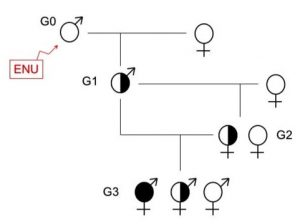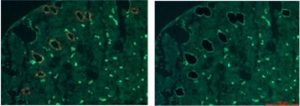Forward Genetic Analysis for Disease Gene Discovery in Mouse Models
A major focus of the lab has been screening ENU-mutagenized mice for defects in organ development. We have pursued a number of different approaches, with specific targets that include craniofacial, cardiac and neurodevelopmental defects.
 These mutants have provided important insight in human disease. For example, we characterized mutations of the gene Fog2 as associated with human congenital diaphragmatic hernia; this was the first causal gene discovered and is the most common mutation characterized in this severe developmental defect. We have also used this method to query neurodevelopment, and have found a novel mutation in the Reelin gene that results in differential receptor binding. More recently we have identified a mutation in the Cogalt1 gene that results in a myopathy.
These mutants have provided important insight in human disease. For example, we characterized mutations of the gene Fog2 as associated with human congenital diaphragmatic hernia; this was the first causal gene discovered and is the most common mutation characterized in this severe developmental defect. We have also used this method to query neurodevelopment, and have found a novel mutation in the Reelin gene that results in differential receptor binding. More recently we have identified a mutation in the Cogalt1 gene that results in a myopathy.
Our present screen is an effort to identify modifying genes that affect Hedgehog mediated organogenesis, craniofacial development, or polycystic kidney disease. Of note is that the positional cloning component is often simply the beginning of the story – the experimental task of understanding mechanistic consequences of developmental defects is challenging and rewarding.
Cilial Genes and Polycystic Kidney Disease
Several of our positional cloning efforts have uncovered genes that play in cilial physiology. For example, Nek8, which is required for normal left-right patterning and which is associated with a cystic kidney disorder, is the only kinase reported to localize to the cilial axoneme. Ttc21b is a component of a complex of proteins that mediate retrograde intraflagellar transport, and our analysis of a conditional mutant have implicated Hedgehog signaling in kidney cystogenesis. Other cilial genes we have identified have been implicated in craniofacial development and hydrocephalus. Most recently, we are applying ENU mutagenesis to discover modifiers of PKD1-mediated cystic kidney disease, testing the role of Hedgehog signaling in cystic kidney disease, and using expression analysis of the the pre-cystic window to uncover causal pathways for cystogenesis.
have implicated Hedgehog signaling in kidney cystogenesis. Other cilial genes we have identified have been implicated in craniofacial development and hydrocephalus. Most recently, we are applying ENU mutagenesis to discover modifiers of PKD1-mediated cystic kidney disease, testing the role of Hedgehog signaling in cystic kidney disease, and using expression analysis of the the pre-cystic window to uncover causal pathways for cystogenesis.
Mutagenesis, Human Population Analysis and Embryonic Development
 Several of our screens have identified genes that are required for normal organ development. Many of these have had limited annotation, such that our functional characterization of these mutations has led to novel insights. More recently we have used a computational analysis of human sequence data to identify genes require for normal development. Uncovering genes not previously appreciated as required for organogenesis is highly rewarding.
Several of our screens have identified genes that are required for normal organ development. Many of these have had limited annotation, such that our functional characterization of these mutations has led to novel insights. More recently we have used a computational analysis of human sequence data to identify genes require for normal development. Uncovering genes not previously appreciated as required for organogenesis is highly rewarding.
Genomic and Imaging Technology and Developmental Genetics
 Sydney Brenner has stated that “progress of science depends on new techniques, new discoveries and new ideas, probably in that order.” We have endeavored to apply new technologies to fundamental questions of biology. These include next-generation sequencing techniques, novel methods of genome modification in both mouse and zebrafish, computational analysis and highly sensitive methods for gene expression analysis.
Sydney Brenner has stated that “progress of science depends on new techniques, new discoveries and new ideas, probably in that order.” We have endeavored to apply new technologies to fundamental questions of biology. These include next-generation sequencing techniques, novel methods of genome modification in both mouse and zebrafish, computational analysis and highly sensitive methods for gene expression analysis.